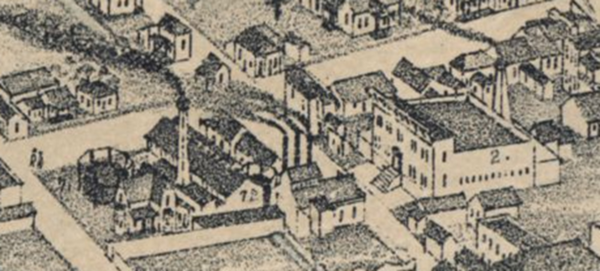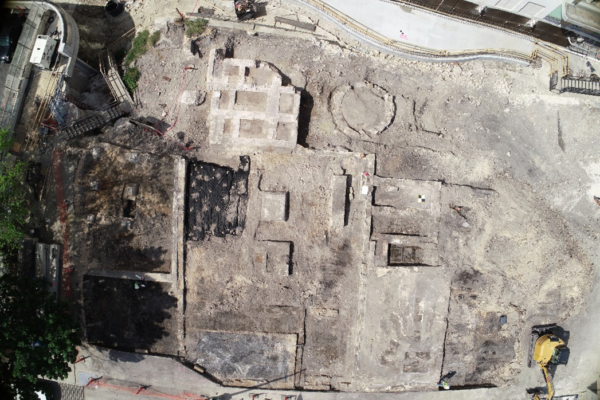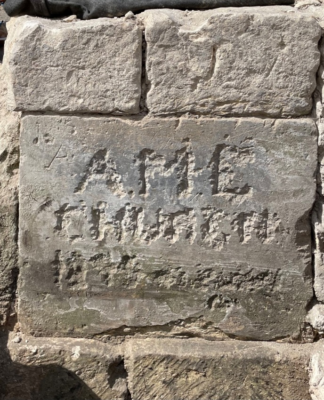A Richly Layered History
English
Español
-
This multi-layered urban cultural site, which was uncovered by archaeologists during construction, is a testament to the confluence of ethnic groups who have directly shaped the unique culture of San Antonio. The sediment encapsulated under these foundations still holds remnants of the lard used by German immigrants Charles and Emilie Klemcke, who established the first commercial soap factory in the region—a cornerstone of modern health and hygiene. The cornerstone, laid in 1875 after four years of fellowship and careful planning by the St. James AME Church, remains a tangible landmark of the thriving Reconstruction-era African American community. Though no longer visible, this site was later home to the Alamo Ice and Brewing Company, where the making of artificial ice was first paired with commercial lager brewing. Careful assessment and community input have allowed this site to be rehabilitated as a gathering place to connect with this dynamic history.
A Timeline: Site on San Pedro Creek
1847
Klemcke Soap Factory was likely established on San Pedro Creek1851
Klemcke Family sold the building to Menger Soap Factory1873
Former Menger Soap Factory purchased by St. James AME Church1880
Alamo Ice Company established their business along San Pedro Creek1885
Alamo Ice Company Sold property to Alamo Brewery1905
Building was demolished
Source: Augustus Koch, “Bird’s Eye View of the City of San Antonio Bexar County Texas, 1873.
Courtesy: Witte Museum, San Antonio.The Alamo Ice Factory is illustrated on this 1886 bird’s-eye view map (#72). The former St. James AME Church building is also visible in the image at the lower right of the circle.

Courtesy: San Antonio Express-News and Hearst Corporation. The site once occupied by the former Menger Soap Works, and later the St. James AME Church, the Alamo Ice Factory, and finally the Alamo Brewing Company is seen here during archaeological excavations. Looking toward the west bank of San Pedro Creek.

Courtesy: San Antonio River Authority. An extensive archaeological investigation revealed the cornerstone of the St. James AME Church, which remarkably survived many years of development on this site. The cornerstone reads:
“AME Church 28 July 1875.” -
Este sitio cultural urbano de múltiples capas, descubierto por arqueólogos durante la construcción, es testimonio de la confluencia de grupos étnicos que han moldeado directamente la cultura única de San Antonio. El sedimento encapsulado bajo estos cimientos aún conserva restos de la grasa de cerdo utilizada por los inmigrantes alemanes Charles y Emilie Klemcke, quienes establecieron la primera fábrica de jabón comercial en la región—una base para la salud e higiene modernas. La piedra angular, colocada en 1875 tras cuatro años de confraternidad y cuidadosa planificación por parte de la Iglesia AME de St. James, sigue siendo un punto de referencia tangible de la próspera comunidad afroamericana de la era de la Reconstrucción. Aunque ya no es visible, este sitio fue posteriormente sede de Alamo Ice and Brewing Company, donde la fabricación de hielo artificial se combinó por primera vez con la elaboración de cerveza comercial. Una evaluación cuidadosa y la participación comunitaria permitieron rehabilitar el sitio como un lugar de encuentro para reconectarse con esta historia dinámica.
Una línea del tiempo: sitio en San Pedro Creek
1847
Klemcke Soap Factor se establece probablemente en San Pedro Creek1851
La Familia Klemcke vende el edificio a Menger Soap Factory1873
La antigua Menger Soap Factory es comprada por la Iglesia AME de St. James1880
Alamo Ice Company estableció su empresa junto a San Pedro Creek1885
Alamo Ice Company vendió la propiedad a Alamo Brewery1905
El edificio fue demolido
Source: Augustus Koch, “Bird’s Eye View of the City of San Antonio Bexar County Texas, 1873.
Courtesy: Witte Museum, San Antonio.La fábrica de hielo de Alamo aparece ilustrada en este mapa panorámico de 1886 (#72). El antiguo edificio de la Iglesia AME de St. James también es visible en la parte inferior derecha del círculo.

Courtesy: San Antonio Express-News and Hearst Corporation. El sitio que alguna vez albergó la fábrica de jabones Menger, y más tarde la Iglesia AME de St. James, la fábrica de hielo de Alamo y finalmente la cervecera Alamo Brewing Company, se muestra aquí durante excavaciones arqueológicas. Vista hacia la orilla oeste de San Pedro Creek.

Courtesy: San Antonio River Authority. Una investigación arqueológica extensa reveló la piedra angular de la Iglesia AME de St. James, que sorprendentemente sobrevivió a muchos años de desarrollo en este lugar. La piedra angular dice:
“Iglesia AME 28 de julio de 1875.”

